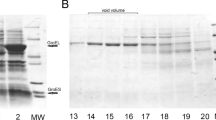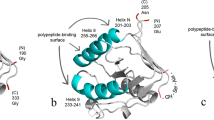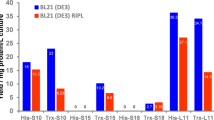Abstract
Within the cellular framework are a number of sequentially operating enzyme systems, in many cases in the form of bi- or even multifunctional proteins each consisting of a single type of polypeptide chain but having two or more catalytic or binding functions. In order to study the properties of an artificial bifunctional enzyme, an in-frame fusion of the structural genes for β-galactosidase (lacZ) and galactokinase (galK) of Escherichia coli was made in vitro. This DNA chimaera was constructed by connecting the 3′-terminus of the lacZ gene to the 5′-terminus of the galK gene. The translated gene product was able to catalyze the sequential reaction normally carried out by the separate native enzymes.
This is a preview of subscription content, access via your institution
Access options
Subscribe to this journal
Receive 12 print issues and online access
$209.00 per year
only $17.42 per issue
Buy this article
- Purchase on Springer Link
- Instant access to full article PDF
Prices may be subject to local taxes which are calculated during checkout
Similar content being viewed by others
References
Mosbach, K. and Mattiasson, B. 1970. Matrix-bound enzymes. Part II. Studies of a matrix-bound two enzyme-system. Acta Chem. Scand. 24: 2093–2100.
Srere, P.A. and Mosbach, K. 1974. Metabolic compartmentation: symbiotic, organellar, multienzymic, and microenvironmental. Ann. Rev. Microbiol. 28: 61–83.
Goldman, R. and Katchalski, E. 1971. Kinetic behavior of a two-enzyme membrane carrying out a consecutive set of reactions. J. Theor. Biol. 32: 243–257.
Koch-Schmidt, A.-C., Mattiasson, B. and Mosbach, K. 1977. Aspects of microenvironmental compartmentation. An evaluation of the influence of restricted diffusion, exclusion effects, and enzyme proximity on the overall efficiency of the sequential two-enzyme system malate dehydrogenase-citrate synthase in its soluble and immobilized form. Eur. J. Biochem. 81: 71–78.
Månsson, M.-O., Siegbahn, N. and Mosbach, K. 1983. Site-to-site directed immobilization of enzymes with bis-NAD analogues. Proc. Natl. Acad. Sci., U.S.A. 80: 1487–1491.
Yourno, J., Kohno, T. and Roth, J.F. 1970. Enzyme Evolution: Generation of a bifunctional enzyme by fusion of adjacent genes. Nature 228: 820–824.
Kalnius, A., Otto, K. Rüther, U. and Müller-Hill, B. 1983. Sequence of the lacZ gene in Escherichia coli. EMBO J. 2: 593–597.
Debouck, C., Riccio, A., Schümperli, D., McKenney, K., Jeffers, J., Hughes, C. and Rosenberg, M. 1985. Structure of the galactokinase gene of Escherichia coli, the last (?) gene of the gal operon. Nucleic Acids Res. 13: 1841–1853.
Zabeau, M. and Stanley, K.K. 1982. Enhanced expression of cro-β-galactosidase fusion proteins under the control of the PR promotor of bacteriophage λ. EMBO J. 1: 1217–1224.
Fowler, A.V. and Zabin, I. 1983. Purification, structure and properties of hybrid β-galactosidase proteins. J. Biol.Chem. 258: 14354–14358.
McKenney, K., Shimataka, H., Court, D., Schmeissner, U., Brady, C. and Rosenberg, M. 1981. A system to study promotor and terminator signals recognized by Escherichia coli RNA polymerase, p. 383–415. In: Gene Amplification and Analysis. Vol. II. Elsevier, N.Y.
Sherman, J.R. and Adler, J.J. 1963. Galactokinase from Escherichia coli. J. Biol. Chem. 238: 873–878.
Miller, J.H. 1972. Experiments in Molecular Genetics. Cold Spring Harbor Laboratory, Cold Spring Harbor, N.Y.
Fowler, A.V. and Zabin, I. 1978. Amino acid sequence of β-galactosidase. J. Biol. Chem. 253: 5521–5525.
Neilsen, D.A., Chou, J., Mackrell, A.J., Casadaban, M.J. and Steiner, D.F. 1983. Expression of a preproinsulin-β-galactosidase gene fusion in mammalian cells. Proc. Natl. Acad. Sci., U.S.A. 80: 5198–5202.
Mandecki, W., Fowler, A.V. and Zabin, I. 1981. Position of the lac Z × 90 mutation and hybridization between complete and incomplete β-galactosidase. J. Bact. 147: 694–697.
Rymond, B.C., Zitomer, R.S., Schümperli, C. and Rosenberg, M. 1983. The expression in yeast of the Escherichia coli galK gene on CYC1:galK fusion plasmids. Gene 25: 249–262.
Bradford, M. 1976. A rapid and sensitive method for the quantitation of protein utilizing the principle of protein-dye binding. Anal. Biochem. 22: 248–254.
Ballard, F.J. 1966. Purification and properties of galactokinase from pig liver. Biochem. J. 98: 347–352.
Kishner, K. and Bisswanger, H. 1976. Multifunctional proteins. Ann. Rev. Biochem. 45: 143–166.
Author information
Authors and Affiliations
Rights and permissions
About this article
Cite this article
Bülow, L., Ljungcrantz, P. & Mosbach, K. Preparation of a Soluble Bifunctional Enzyme by Gene Fusion. Nat Biotechnol 3, 821–823 (1985). https://doi.org/10.1038/nbt0985-821
Received:
Accepted:
Issue Date:
DOI: https://doi.org/10.1038/nbt0985-821
This article is cited by
-
Fast and reliable production, purification and characterization of heat-stable, bifunctional enzyme chimeras
AMB Express (2015)
-
Bringing functions together with fusion enzymes—from nature’s inventions to biotechnological applications
Applied Microbiology and Biotechnology (2015)
-
Developmental strategies and regulation of cell-free enzyme system for ethanol production: a molecular prospective
Applied Microbiology and Biotechnology (2014)
-
Biotechnological production and applications of N-acetyl-d-neuraminic acid: current state and perspectives
Applied Microbiology and Biotechnology (2010)



